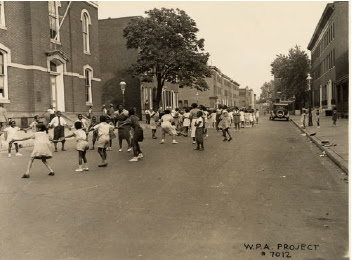The structure with flames leaping through the roof and out the upper windows was, indeed, large, old and historic. The three alarm fire brought out a large amount of apparatus blocking several West Baltimore arteries such as McCulloh Street and Druid Avenue, the neighborhood was cloaked in grey smoke.
 |
| Historic School PS 103 on fire last week (photo ArchPlan ) |
The fire forced Marble Hill neighbor Marti Pitrelli into the street from where she snapped pictures and alerted her friends via Facebook. "Its maddening" she sad, "they had just used federal grant money to stabilize it, now this." Eli Pousson from Baltimore Heritage stood by with a larger camera, he too was condemned to document the destruction instead of the better future that had been envisioned.
A better future was planned for the historic two-story former Elementary School PS 103, dating back to 1877, whose most famous pupil was Thurgood Marshall (1914-21). The school is such a prominent structure that around 2008 the Mayor had appointed its own 103 Commission which oversaw the preparation of a long-range plan for PS103 with assistance from the Baltimore National Heritage Area. Three separate studies were undertaken and reports prepared to guide rehabilitation and interpretation of the historic property. Money came from the prestigious federal Preserve America grant.
The Commission involved the community and established five guiding principles, among them the importance of Thurgood Marshal, the history of schooling and that the building shall continue to serve the community. Three reports were published The school represented a school model developed by architect John Husband in 1868 (originally designed as Grammar School #6 for white immigrant students):
14 classrooms, a principal’s, office on each level, stairs at the front and rear, sash partitions, standing approximately 60 feet, wide and 129 feet deep. Furthermore, the school exemplifies the Board’s stated priority of design that promotes health and safety, especially through lighting, ventilation, and appropriate egress in case of fire.
 |
| Livelier days on Division Street, 1934 (from the reports) |
Now here the stately two-story brick former school was engulfed in flames that threatened to consume not only the building but another dream of a better future for Upton. Eyeing the general desolation up and down Division Street where the buildings stands, it is difficult not to think about Governor Hogan's demolition funds born from the notion that it would be best "to tear it all down". But this school and a great number of grand historic structures right around the corner from PS 103 are a solid testimony to Upton's better past. They stand to remind us that it is this City's duty to maintain this history, respect the past and rebuild instead of demolish, as hard as it may seem.
 |
| Rendering of Grammar School #6, 1877 (from the reports) |
Given the extensive needs for community spaces and accommodation for the less fortunate, one can wonder whether the goals of the 103 Commission were not too lofty and whether an intermediate use as a shelter or community center wouldn't have been better than mothballing the space. Likely funds and staff to pull that off were just as elusive as the developers to realize the report's goals.
Hope remains that the Baltimore Fire Department was fast and effective enough so that the structure itself remains stable and repair work mostly confined to the roof. For the time being the structure was deemed too unsafe to enter, though and any other findings are not known.
Maybe the the PS 103 Commission has to reconvene to pull off a miracle similar to the one of Mary Harvin Center in East Baltimore which burnt to the ground last year on the evening of the Baltimore unrest. An unrest which most blame on the conditions right here where PS 103 burnt, in West Baltimore.
Klaus Philipsen, FAIA
Baltimore Heritage
 |
| Front elevation (from the reports) |
 |
| Fire fighting from the rear alley (photo ArchPlan Inc.) |
 |
| Interior before the fire (from the reports) |
 |
| Existing second floor plan before the fire (from the reports) |
 |
| Bethel AME Church on W. Lanvale, right around the corner from PS 103 (photo: ArchPlan Inc.) |
No comments:
Post a Comment